Abstract
Recycling means that the wastes that can be taken into the re-evaluation process are re-included in theproduction process by going through many different processes and being processed. In this way, materialsthat are waste after use are transformed back into raw materials by various methods, contributing to themanufacturing process and thus minimizing the need for raw materials. As the consumed materials can beincluded in the recycling cycle, the decrease in the need for raw materials ensures that the consumptionthat increases in parallel with the increase in the human population disrupts the natural balance andprevents the damage to the nature. At the same time, it also allows for large amounts of energy savings.The use of waste materials resulting from consumption as raw materials also plays a major role inpreventing environmental pollution. For example, the inclusion of a paper material in production by goingthrough the recycling process again significantly reduces air pollution, water pollution and also waterusage. Wastes, which disrupt the natural balance and allow too much tree cutting and harm to nature, areeliminated thanks to recycling and the risky situation of nature has started to disappear thanks torecycling. Both nature conservation and energy, etc. Recycling is an inevitable result to ensure savings.
Netpak is a company that has given attention and importance to recycling since its establishment. Fromthe first day, it has used all its Ar-ge and urge studies for the production of materials with recycled rawmaterials and materials with ease of use, elegance and strength. Netpak protects nature and givesconfidence to the future by making bags from recycled materials. NetEco is the project that NetpakAmbalaj has developed to catch the speed of technology and brought together the superior technologicalelements. These bags are the result of recycled plastics being used between layers for the second time.Thanks to the advanced technology, the bag can be recycled after use and transformed into another bag.With the continuation of this cycle, the use of raw material resources, which is used many times, isreduced.
Introduction
In this article, information will be given about the effects of recycling on humans and nature, types of waste,waste management, recycling and about NetEco. Recycling is the inclusion of wastes, which have thepossibility of recycling, into the production process by transforming them into secondary raw materials asa result of many physical and chemical interventions. In other words, it is known as the recycling ofproducts that are used in any way and which are no longer used as raw materials with various recyclablemethods. In the rapidly developing and globalizing world, with the effect of industrialization andurbanization, resources are used unconsciously and wastes arise as a result of this unconsciousconsumption. These wastes affect the nature, human life and health as well as the economic situation of thecountry. The problem we encounter with this increasing waste rate has affected the society, family,individual and most of all nature.
The main purpose of recycling is to prevent the unnecessary use of the resources to be used and to reducethe amount of residual waste by separating the waste at the source. Iron, steel, copper, lead, paper, plastic,glass, etc. The fact that materials such as wastes can be recycled and reprocessed will prevent the use ofother new raw materials. By contributing to recycling, both natural resources are preserved and our limitednaturalness can be preserved by using recyclable wastes instead of producing new ones. Less space can bemade available for less waste, thus contributing to the economy. Netpak has been by the side of nature bysupporting recycling from the first day to this day with advanced technologies in this field. NetEco, theproject developed by Netpak Ambalaj, to keep up with the speed of technology. These bags are the resultof recycled plastics being used between layers for the second time. Thus, a used bag can be recycled againand create a new bag.
Purpose and Importance
The purpose of this article is to support recycling. To explain the effects and benefits of recycling on humanlife. Informing the society about recycling and wastes, ways to protect nature, the possibilities of recyclingof wastes are explained. To present the NetEco project created by Netpak packaging and to reflect therecycling contributions they have developed in this field.
History of Recycling
The resource constraints arising from wars were effective in the beginning of the need for recycling. Duringthe second world war, big countries started to make moves regarding recycling. Citizens are encouraged tocollect metal and fiber materials.
The most important element of education, which is the most important element, has been used in order toincrease the awareness of recycling to the people. Recently, recycling has been given great importance ineducational programs in the world. The contribution of recycling to the future of the world is included inthese programs under the heading of environmental awareness. In particular, materials that can be easilyrecycled such as paper, plastic bottles and jars are the main items of recycling ideas implemented in schools.
Economy is as effective as education in the success of recycling. Only consumers who have sufficientpurchasing power can turn to environmentally friendly options. This may encourage manufacturers toincrease the amount of recycled material in their products. As a result, interest and preference for recyclinghas increased.
What Can Be Recycled?
Glass, Paper, Aluminum, Plastic, Batteries, Engine oil Accumulators, Concrete, Organic wastes,Electronic wastes, Iron, Textile, Wood, Metal and Solvent Based Wastes. Wastes can be classifieddepending on different external factors such as consumption, production, chemical and physicalproperties. Accordingly, wastes are generally divided into solid wastes, liquid, gas and packaging wastes.Solid wastes consist of seven sections according to location, order and category. These; domestic solidwastes, industrial wastes, dangerous wastes, special wastes, medical wastes, agricultural and gardenwastes, construction wastes and rubble wastes.
- Universal Waste;
It is domestic and industrial wastes that can be collected and transported by normal municipal service,disposed of in household waste landfills, recycled by separation, composted or incinerated. Kitchenwaste, packaging waste, office waste, etc. They are waste (Gündüzalp,güven p: 3).
- Dangerous Wastes;
It is classified into 15 separate sections according to the danger. Explosive, oxidizing, highly flammable,irritant, harmful, toxic, carcinogenic, corrosive, infectious, mutagenic, substances or preparations thatrelease toxic or highly toxic gases as a result of contact with air, water or an acid (Gündüzalp,güven s: 3).
- Industrial Wastes;
It is wastes arising from industrial activities. It covers wastes generated during industrial processes and /or as a result of industrial processes.
- Agricultural and Garden Waste;
It is the waste and residues that are generated as a result of obtaining and processing plant and animalproducts. The amount and content characteristics of the solid wastes produced are determined by thesocioeconomic characteristics of the society, nutritional habits, geography, etc. It is affected by differentconditions.
- Special Wastes;
They are wastes of special importance to be disposed of. Radioactive wastes, dangerous and harmfulindustrial wastes, paint, thinners, cleaning agents, batteries etc. in domestic wastes. rubber wheels,wastewater sludge, construction and demolition wastes and hospital wastes are from this group(Gündüzalp,güven p: 3).
- Medical Wastes;
It is the waste generated as a result of the use of materials used in the medical field. Since it is medical,there is a risk of being dangerous and chemical.
- Construction Residue and Rubble Waste;
Disposal of materials used in construction as a result of construction, rubble, concrete pieces, etc. It canbe defined as.
Waste types are not limited to solid wastes only. In addition, there are liquid, gas and packaging wastes.Liquid and gaseous, liquid wastes; hospital-sourced blood, dentistry, washing water and so on. They arematerials. Gases, on the other hand, are used in nuclear power plants, industrial plant chimneys, garbagestorage areas, etc. Are resources. Another type of waste is packaging waste. Packaging according to theEuropean Union Packaging and Packaging waste directive; It is all of the recyclable and non-recyclableproducts made from any material used for transportation, protection, storage and sale at the stage ofdelivering a product from the raw material to the processed product (Gündüzalp,güven p: 4).
There are also packaging wastes in commercial terms. In commercial terms, packaging wastes are dividedinto three sub-sections as sales packaging, outer packaging, and transport packaging. Packaging Waste interms of Material Type: It is divided into six sub-headings as paper, plastic, metal, glass, wood andcomposite packaging.
- Paper;
Paper is first broken into fibers in water for the preparation of paper slurry. Sodium hydroxide or sodiumcarbonate is used as ink separator. Then the ready-made paper fibers are used in the production ofrecycled paper.
Paper is one of the important necessities of humanity, and the development of the paper industry isconsidered as one of the determining factors of a country's industrial and cultural development levels.Waste paper cannot be recycled continuously. If a certain amount of paper is continuously recycled, theend-use limits are reached in a very short time.
- Plastic;
Plastic wastes are primarily separated according to their types. Recyclable plastic wastes separatedaccording to their types are broken into small pieces in crushing machines. Businesses can use these partsdirectly in the production process by mixing them with the original raw material in certain proportions; Itcan also be used as second class raw material by melting again and adding additives.
- Metal;
Metal is produced as a result of processing and purification of various minerals that make up the earthlayer. It is then collected separately from other wastes in the recycling stage. It is discarded by reducingits volume. With the help of large magnet systems, aluminum, steel, etc. in the stack. Separates suchmaterials from each other. After the grinding process, it is melted in high-temperature furnaces. Then,metal blocks are formed by pouring into the mold. These metal blocks are pressed to the desiredthickness. As a result of recycling from waste metals, paint boxes, white goods, metal profiles, bicycles,etc. Used in industries.
-Pine;
Bottles, jars, glass cups, vases and other glass wastes are collected separately in collection boxes or wherethe waste is generated, and these wastes are separated according to their colors and given to recyclingfacilities. Here it is separated from waste and additives. Glass materials are broken and mixed into the rawmaterial mixture and poured into melting furnaces. Broken glass is also used as concrete additive and glassasphalt. Glasses can be recycled indefinitely, without any deformation in their external structures.-Wooden;First of all, the parts to be considered as waste and the parts that are reusable are collected separately. It isnot mixed with other wastes during collection. Wood waste is processed in recycling facilities and materialrecycled, and it is used in the production of wood products again, and it provides the conservation ofresources.
Recycling, Nature and Environment
Efficient and systematic waste management ensures that all wastes are disposed of in a controlled manner,recycled, minimized the damage to nature and human beings, and recycled these discarded products. Ifwaste is not managed properly, it can pose a serious health hazard (Gündüzalp, Güven p: 9). Therefore,waste management has led to the emergence of very effective solutions. Otherwise, wastes can result inimportant and dangerous consequences. In recycling, the amount of waste is incinerated, refilled or buried.In addition to its economic benefits, it also has positive effects on the environment. As a result, pollutiondecreases, the amount of solid waste that needs to be disposed of is reduced, it enables us to save energyand leave a clean environment for future generations.
Our natural resources are decreasing day by day due to the increase in the world population and the changein consumption habits. The water used, energy resources, waste each affects them very much. For thisreason, it is necessary to reduce material consumption and to use natural resources efficiently by recyclingrecyclable waste.
Forests, water, etc. As a result of using our natural resources in production processes, glass, metal, plasticand paper packaging is obtained. After the packages put on the market become waste, they become rawmaterials for the products that will be produced after they are separated according to their types andtransformed in the recycling industries.
This makes it possible to use our natural resources less and contribute to nature. The use of used packagingand similar recyclable wastes as a raw material source results in significant savings such as the protectionof the raw material or natural resource that should be consumed for the material used instead. Our naturalresources are decreasing day by day due to the increase in the world population and consumption. For thisreason, our natural resources should be used more efficiently.
Recycling and Economy
Recycling is also an efficient long-term economic investment. The decrease in raw materials and the rapidconsumption of natural resources can cause economic problems. Recycling can have positive effects on theeconomy at this point. The decrease in the consumption of energy and natural resources plays a veryimportant role for the country's economy.
Recycling, petrol and so on, where the country is dependent on foreign countries. It contributes to theeconomy by minimizing the consumption of raw materials. By selling our products such as synthetic fibers,which are formed as a result of recycling, foreign currency inflow is provided to our country.
-Energy saving is provided; recycling saves energy by reducing the number of industrial processes inmaterial production. Since the number of physical and chemical processes applied during recycling is lessthan normal production processes, a significant energy saving is achieved in the production of materials by recycling.
Recycling Symbols
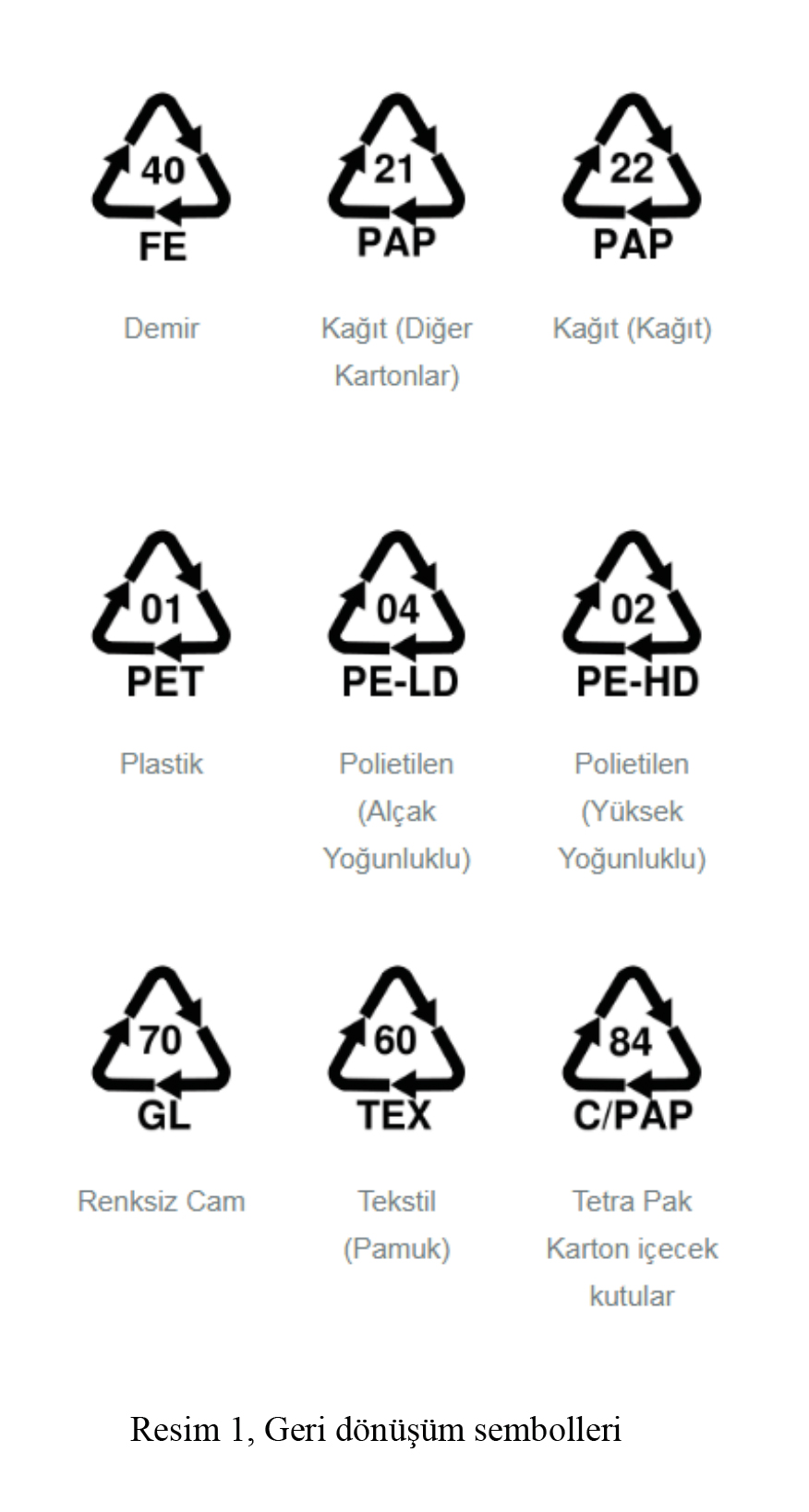
Netpak Packaging
Packaging industry experience Netpak pioneer in Turkey in the upcoming 40 years, it is one of the top threeproducers in Europe. Company philosophies are based on continuous improvement and innovation. It offersdifferent products to the sector by allocating large funds to Ar-ge and new product studies. Netpakmanufactures environmentally friendly products with this sensitivity and performs the design andproduction of these products, from the design to the automation of the production techniques andequipment, and continues to receive serious awards in this regard. In addition to the awards they havereceived on environment, energy and sustainability, they have Ar-ge and patent awards and state-sponsoredprojects.
Netpak Ambalaj focuses on environmentally friendly packaging in its commercial process and produceseco-friendly ultrasonic-sourced cloth bags and eco-friendly bags, which it has certified with an examinedpatent as a result of its research on this subject. Netpak Ambalaj AŞ. It serves in a wide range of productionareas ranging from environmentally friendly carrying bags to advertising bags and environmentally friendlypackaging. The reason for the existence of the organization is to provide its customers with products ofsuperior service and quality, to have a knowledge of the renewal power in accordance with the conditionsof the day, to maintain its current image, to continue its production and trade in accordance with businessethics, occupational safety and environmental standards. It produces domestic capital, raw materials, Ar-gedesigns with superior machines and continues to work for new products.
Long Life Tote Bags
Tote bags produced as Netpak packaging are environmentally friendly and long-lasting. The longevity ofcloth bags will reduce resource use and save money by repeated use. Cloth bags consist of 100% recyclableraw materials. It can be recycled effectively when its lifespan is over, and it can be recycled 100%. Clothbags are eco-friendly at the same time. Tote bags, which cannot be recycled at the end of their useful life,can be mechanically decomposed and mixed into the soil under natural conditions when left to nature andhave organic nutritional value. NetEco project, created by Netpak Ambalaj, designed to catch up with thespeed of technology, has achieved a new business with layered tote bags with new generation nonwoven fabric.
Net Eco
Recycling is the re-inclusion of wastes that can be recycled into the production process through variousprocesses. In other words, materials that turn into waste after use are used as raw materials after variousphysical and chemical processes are applied then it will be ready for manufacturing processes.
This is our second life. This bag can be used for the second time as another bag by using recycled plasticsbetween layers with the technology which was developed by Netpak Ambalaj. With the continuation of thiscycle, the raw material used many times will decrease the resource usage.
Netpak is a company that has given care and importance to this technology since its establishment. AllAr-ge work has been recycled from the first day.We use this technology for the production of materialswith ease of use, elegance and strength with raw materials from recycled materials.
Let's meet at the new trend NetEco to make bags, to protect nature, to give confidence to the future and tolive with speed of technology.
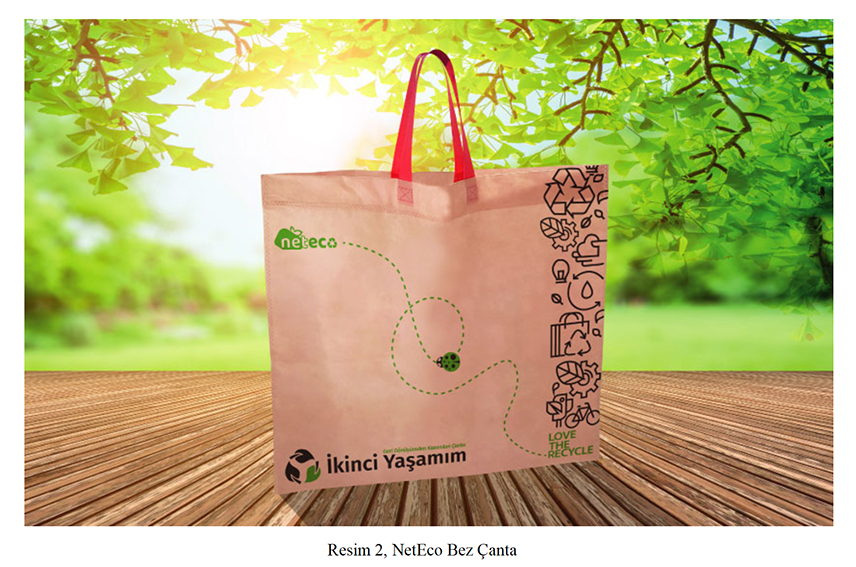
NetEco creates the tote bags that it has produced with superior technological machines by combininglayers with different technologies. These layers are shown in the image below. Cloth bags with NonwovenFabric are obtained from 100% recyclable raw material. Thus, it minimizes the use of raw materials andcreates environmentally friendly bags.
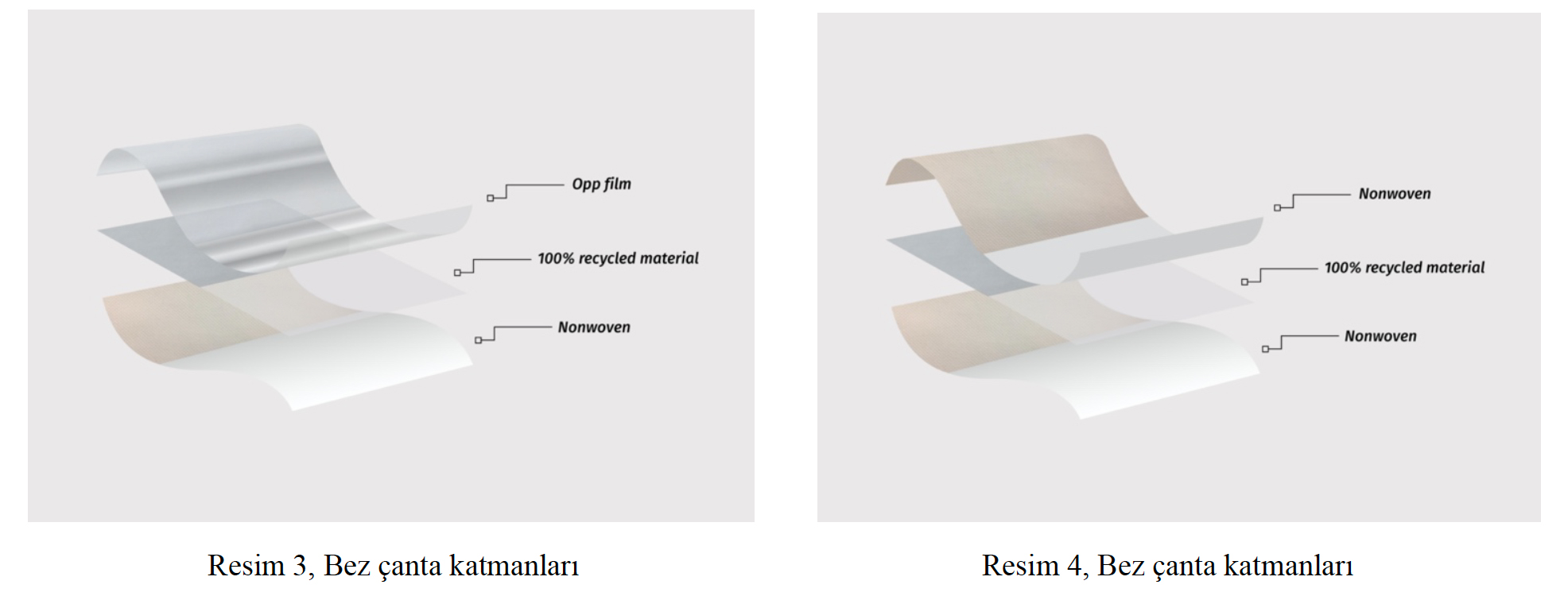
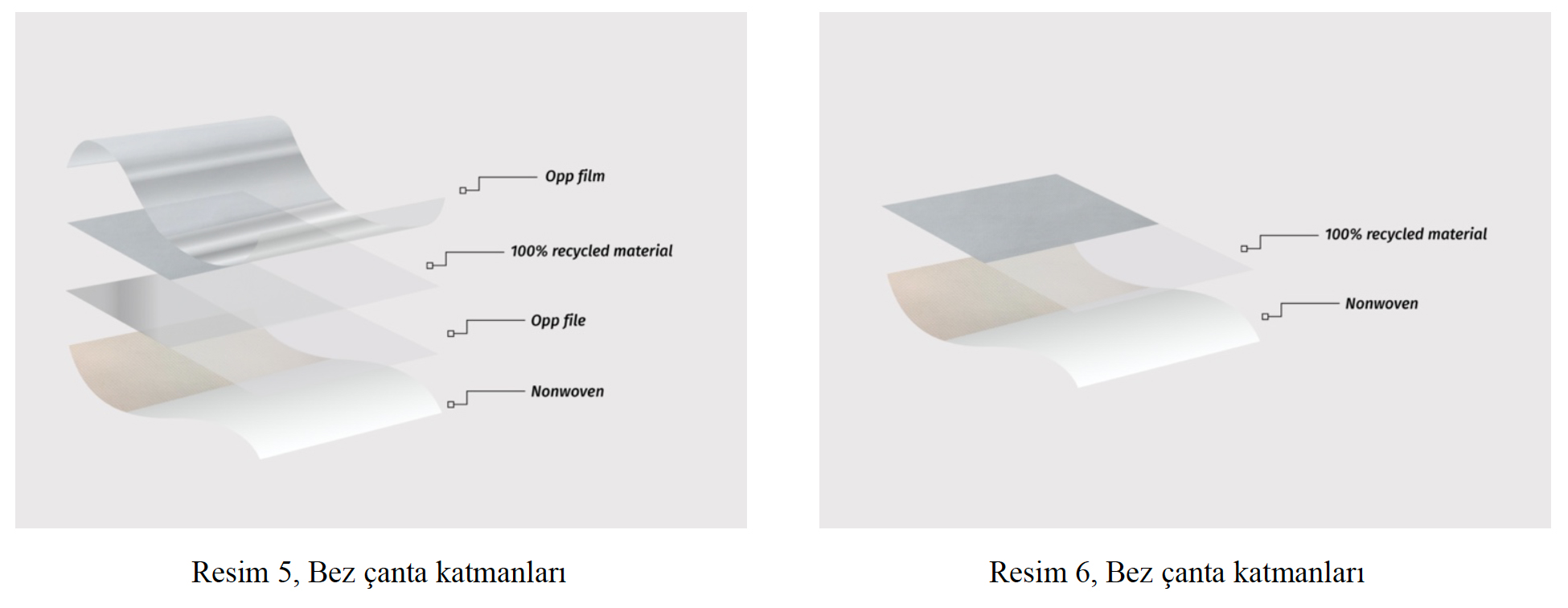
RESULT
Considering that the amount of consumption increases day by day and this amount of waste is generatedand all these create environmental, social, economic, health and global problems; We see how importantrecycling is. The necessity of being at an important point as much as basic needs means that largeorganizations, companies, public institutions and organizations have a lot of responsibility in this regard.
Recycling should become a part of our lives, and this production should be constantly used in waste. Ifrecycling is not in our lives, the results that will be seen are not very welcome. For this reason, the type andproduction methods of the materials used are of great importance in terms of being recyclable. Recyclingpreserves natural resources and saves energy and water. Thanks to this, as the amount of waste going tolandfill facilities is reduced, the useful life of garbage storage areas extends, the environment becomescleaner and most importantly, nature is protected. Dozens of trees cut for a single piece of paper areminimized thanks to recycling.
Netpak Ambalaj is one of the leading companies in recycling throughout its sector, which has been closeto 40 years from the past. Since its establishment, they have carefully supported recycling with care andgreat care. Netpak packaging, founded on continuous development and innovation, attaches greatimportance to Ar-ge and new product studies. Netpak Ambalaj focuses on environmentally friendlypackaging in its commercial process and produces eco-friendly ultrasonic-sourced cloth bags and ecofriendlybags, which it has certified with an examined patent as a result of its research on this subject. Inline with these sensitivities, they produce environmentally and nature friendly 100% recyclable tote bags.Netpak company has revealed the NetEco project, where it will start the production of new tote bags withnonwoven fabric technology with superior technologies to catch up with the technology. In this way,healthy, reliable and useful recyclable diaper bags that support 100% recycling enable them to meet people.
REFERANCE
- Gündüzalp, A. A. ve Güven, S. Atık, Çeşitleri, Atık Yönetimi, Geri D.nüşüm ve Tüketici:Çankaya Belediyesi ve Semt Tüketicileri Örneği, Ankara
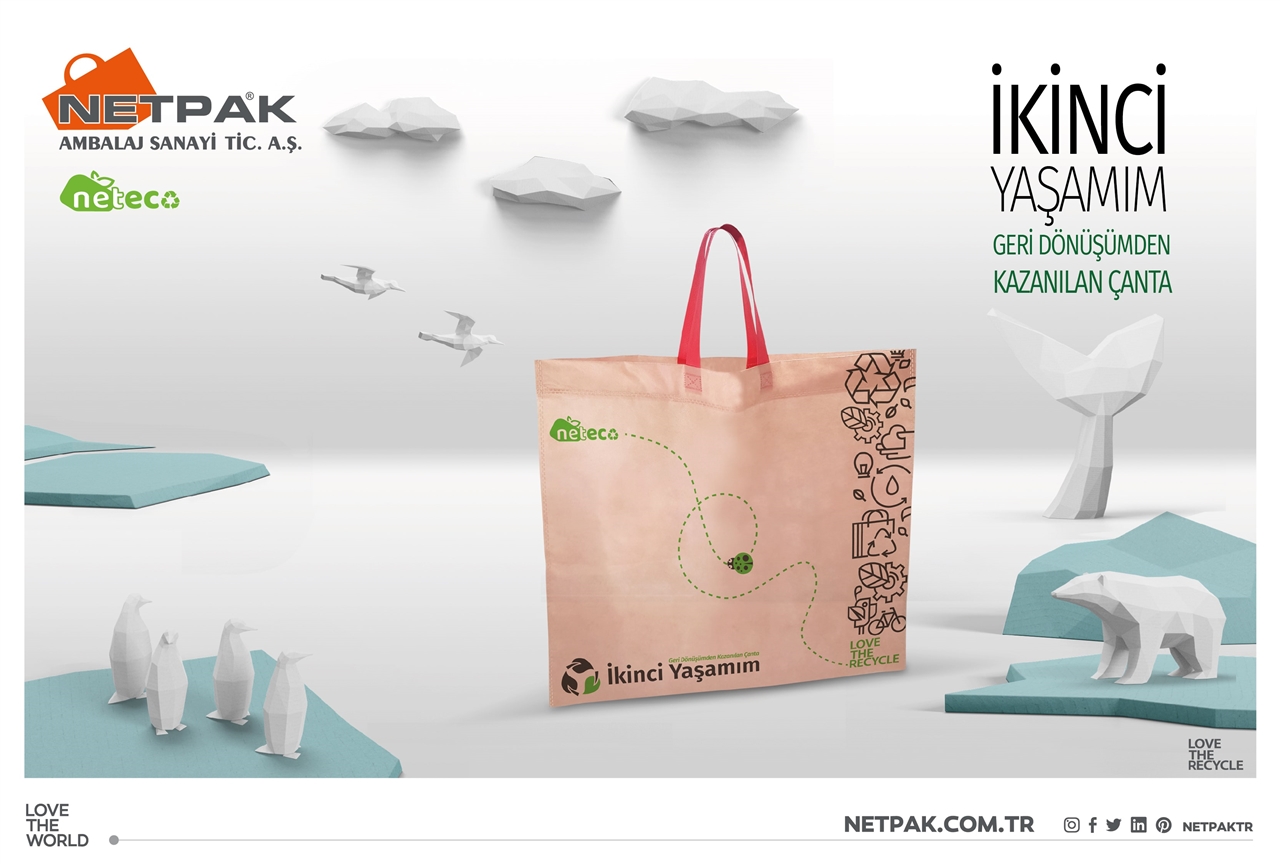
11.08.2021